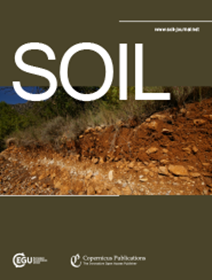Interactions of fertilisation and crop productivity in soil nitrogen cycle microbiome and gas emissions
IF 4.3
2区 农林科学
Q1 SOIL SCIENCE
引用次数: 0
Abstract
Abstract. Fertilised soils are a significant source of nitrous oxide (N2O), a highly active greenhouse gas and a stratospheric ozone depleter. Nitrogen (N) fertilisers, while boosting crop yield, also lead to N2O emissions into the atmosphere, impacting global warming. We investigated relationships between mineral N fertilisation rates and additional manure amendment with different crop types through the analysis of abundances of N cycle functional genes, soil N2O and N2 emissions, nitrogen use efficiency (NUE), soil physicochemical analysis and biomass production. Our study indicates that N2O emissions are predominantly dependent on the mineral N fertilisation rate and enhance with an increased mineral N fertilisation rate. Crop type also has a significant impact on soil N2O emissions. Higher N2O emissions were attained with the application of manure in comparison to mineral fertilisation. Manure amendment also increased the number of N cycle genes that are significant in the variations of N2O. The study indicates that N2O emissions were mainly related to nitrification in the soil. Quantification of nitrogen cycle functional genes also showed the potential role of denitrification, comammox (complete ammonia oxidation) and dissimilatory nitrate reduction to ammonium (DNRA) processes as a source of N2O. Our study did not find soil moisture to be significantly linked to N2O emissions. The results of the study provide evidence that, for wheat, a fertilisation rate of 80 kg N ha−1 is closest to the optimal rate for balancing biomass yield and N2O emissions and achieving a high NUE. Sorghum showed good potential for cultivation in temperate climates, as it showed a similar biomass yield compared to the other crop types and fertilisation rates but maintained low N2O emissions and N losses in a mineral N fertilisation rate of 80 kg N ha−1.施肥与作物生产力在土壤氮循环、微生物群和气体排放中的相互作用
摘要。肥沃的土壤是一氧化二氮(N2O)的重要来源,一种高度活跃的温室气体和平流层臭氧消耗物。氮肥在提高作物产量的同时,也导致一氧化二氮排放到大气中,影响全球变暖。通过对不同作物类型的氮素循环功能基因丰度、土壤N2O和N2排放、氮素利用效率(NUE)、土壤理化分析和生物量产量的分析,探讨了矿质氮施肥量与外加肥料改改量之间的关系。我们的研究表明,N2O的排放主要依赖于矿质氮的施肥量,并随着矿质氮施肥量的增加而增加。作物类型对土壤N2O排放也有显著影响。与矿物施肥相比,施用粪肥获得了更高的N2O排放量。肥改也增加了氮素循环基因的数量,这些基因对氮氧化物的变化有显著影响。研究表明,N2O排放主要与土壤的硝化作用有关。氮循环功能基因的定量也显示了反硝化、comammox(完全氨氧化)和硝酸异化还原成铵(DNRA)过程作为N2O来源的潜在作用。我们的研究没有发现土壤湿度与N2O排放有显著联系。研究结果表明,对于小麦而言,80 kg N ha - 1的施肥率最接近平衡生物量产量和N2O排放并实现高氮肥利用效率的最佳施肥率。高粱在温带气候条件下具有良好的种植潜力,因为与其他作物类型和施肥率相比,高粱的生物量产量相似,但在80 kg N ha - 1的矿物肥施肥量下,高粱的N2O排放和N损失保持在较低水平。
本文章由计算机程序翻译,如有差异,请以英文原文为准。
求助全文
约1分钟内获得全文
求助全文
来源期刊

Soil
Agricultural and Biological Sciences-Soil Science
CiteScore
10.80
自引率
2.90%
发文量
44
审稿时长
30 weeks
期刊介绍:
SOIL is an international scientific journal dedicated to the publication and discussion of high-quality research in the field of soil system sciences.
SOIL is at the interface between the atmosphere, lithosphere, hydrosphere, and biosphere. SOIL publishes scientific research that contributes to understanding the soil system and its interaction with humans and the entire Earth system. The scope of the journal includes all topics that fall within the study of soil science as a discipline, with an emphasis on studies that integrate soil science with other sciences (hydrology, agronomy, socio-economics, health sciences, atmospheric sciences, etc.).
 求助内容:
求助内容: 应助结果提醒方式:
应助结果提醒方式:


